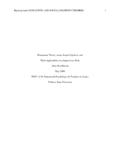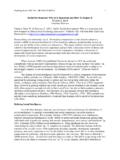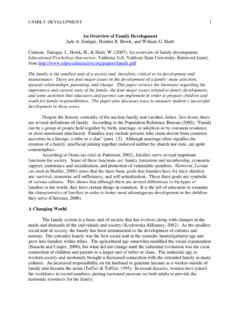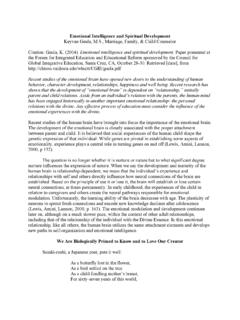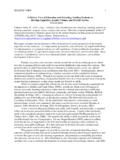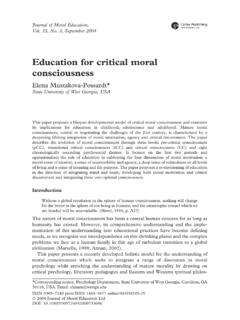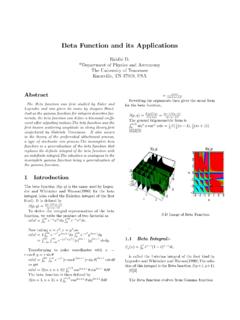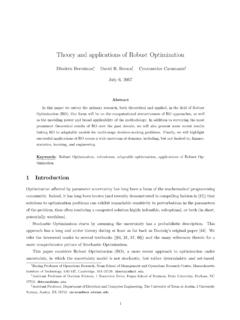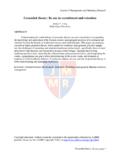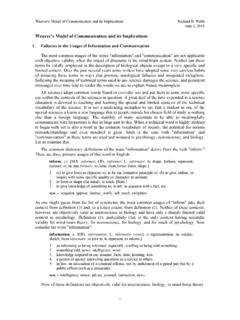Transcription of Information Processing and Memory: Theory and …
1 Information Processing 1 Information Processing and Memory: Theory and applications Stacey T. Lutz William G. Huitt Citation: Lutz, S., & Huitt, W. (2003). Information Processing and memory: Theory and applications . Educational Psychology Interactive. Valdosta, GA: Valdosta State University. Retrieved [date], from This paper discusses theories associated with Information Processing and memory. It includes descriptions and definitions of important terms and models that have been used to depict memory types and processors. The frameworks associated with the stage Theory model and schools of thought on pattern recognition and representation models are discussed as well as those on schema, parallel distributed Processing , and connectionist models.
2 The paper ends with discussion on the assessment of cognitive Processing in education today and activities for developing instruction that is built on the theories discussed. Educators are very interested in the study of how humans learn. This is because how one learns, acquires new Information , and retains previous Information guides selection of long-term learning objectives and methods of effective instruction. To this end, cognition as a psychological area of study goes far beyond simply the taking in and retrieving Information . It is a broad field dedicated to the study of the mind holistically. Neisser (1967), one of the most influential researchers in cognition, defined it as the study of how people encode, structure, store, retrieve, use or otherwise learn knowledge.
3 Cognitive psychologists hypothesize an intervening variable or set of variables between environment and behavior which contrasts it with behavioral theories. Information Processing and Memory One of the primary areas of cognition studied by researches is memory. There are many hypotheses and suggestions as to how this integration occurs, and many new theories have built upon established beliefs in this area. Currently, there is widespread consensus on several aspects of Information Processing ; however, there are many dissentions in reference to specifics on how the brain actually codes or manipulates Information as it is stored in memory. Schacter and Tulving (as cited in Driscoll, 2001) state that a memory system is defined in terms of its brain mechanisms, the kind of Information it processes, and the principles of its operation (p.)
4 283). This suggests that memory is the combined total of all mental experiences. In this light, memory is a built store that must be accessed in some way in order for effective recall or retrieval to occur. It is premised on the belief that memory is a multi-faceted, if not multi-staged, system of connections and representations that encompass a lifetime s accumulation of perceptions. Eliasmith (2001) defines memory as the general ability, or faculty, that enables us to interpret the perceptual world to help organize responses to changes that take place in the world (p. 1). It is implied by this definition that there must be a tangible structure in which to incorporate new stimuli into memory.
5 The form of this structure has been the source of much debate, and there seems to be no absolute agreement on what shape a memory structure actually Information Processing 2 takes, but there are many theories on what constitutes both the memory structure and the knowledge unit. Winn and Snyder (2001) attribute the idea that memory is organized into structures to the work of Sir Frederick Charles Bartlett. Bartlett s work established two consistent patterns regarding recall. First, memory is inaccurate. This finding is not surprising or novel today, but its implications will be discussed later in this paper. His second finding, though, brought about somewhat of a revolution in traditional thinking about memory.
6 Bartlett suggested that the inaccuracy of memory is systematic. A systematic difference makes allowable the scientific study of inaccuracy, and this suggestion led to an entirely new mode of thought on memory. What accounted for systematic inaccuracies in memory were the intervening influences of previous Information and the experiences of the person. This demonstrates that knowledge units are not simply stored and then left alone, but that they are retained, manipulated, and changed as new knowledge is acquired. Despite disagreement on many levels, there is general agreement among most cognitive psychologists on some basic principles of the Information Processing system Huitt (2000). First, there is the assumption of a limited capacity.
7 Depending on the Theory , these limitations occur at different points in Information Processing , but it is widely held in all models that there are limitations as to how much and at what rate new Information can be encoded, stored and retrieved ( , Broadbent, 1975; Case, 1978) Most cognitive psychologists also agree that there exists some type of control system for dealing with stimuli ( , Atkinson & Shiffrin, 1971). Again, exactly how and where the controls operate is a question of some debate, but the actuality of some type of system that requires some Processing capacity is generally accepted. The belief in the interaction of new Information with stored Information is a third key point of cognitive study.
8 This is usually demonstrated with a bottom-up or top-down system or a combination of the two. A bottom-up system is predicated on the belief that new Information is seen as an initiator which the brain attempts to match with existing concepts in order to break down characteristics or defining attributes ( , Gibson, 1979). A top-down system seems to suggest an opposite approach. The existing Information is the initiator and memory representations are evaluated, then matched to the stimuli ( , Miller, Galanter, & Pribram, 1960). Finally, there is also agreement that humans have specific genetic traits that dictate the method by which they gain new Information . For example, all human infants make the same vocalizations during the first six months, regardless of the language spoken around them (Flavell, Miller, & Miller, 2002).
9 After that, infants begin to vocalize the sounds of the mother tongue and omit sounds not found in that language (Jusczyk, 1997). It has also been discovered that infants begin to lose the ability to discriminate sounds not in the mother tongue at about six to seven months of age (Werker & Tees, 1999). All of these factors play a significant role in the development and understanding of how the mind operates, but they are only the starting point, or maybe more accurately the dividing point, for more in depth models for Information Processing . The Stage Model Traditionally, the most widely used model of Information Processing is the stage Theory model, based on the work of Atkinson and Shiffrin (1968).
10 The key elements of this model are that it views learning and memory as discontinuous and multi-staged. It is hypothesized that as new Information is taken in, it is in some way manipulated before it is stored. The stage Theory Information Processing 3 model recognizes three types or stages of memory: sensory memory, short-term or working memory, and long-term memory. Figure 1. A stage model of memory Sensory memory. Sensory memory represents the initial stage of stimuli perception. It is associated with the senses, and there seems to be a separate section for each type of sensual perception, each with its own limitations and devices. Obviously, stimuli that are not sensed cannot be further processed and will never become part of the memory store.
